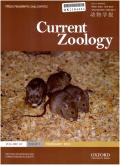基于形态学的水生昆虫飞行能力分类:第一次尝试
IF 2
2区 生物学
Q2 ZOOLOGY
引用次数: 0
摘要
飞行是新兴水生昆虫繁殖和传播的关键特征。然而,昆虫飞行的形态学测量主要用于陆地分类群和蜻蜓,而水生昆虫的研究很少。本文分析了新兴水生昆虫(蜉蝣目、毛翅目、翼翅目、双翅目和大翅目)5目32个类群的7个与飞行相关的形态学参数,这些类群具有不同的与飞行相关的生活史特征(分散策略、飞散性、成虫寿命和群体行为)。在纠正异速生长后,我们使用无优先级的方法根据他们的飞行相关形态对个体进行聚类。然后,我们探讨了这些类群、分类和一些生活史特征之间的一致程度。所有的目都分散在几个集群中,表明飞行能力范围很大,特别是双翅目。我们在每个群集中都发现了群集类群,这表明水生昆虫对群集的形态适应并不相同。这些聚类不符合文献或数据库中分类群的预期扩散能力。重的宽翅昆虫,特别是聚集的分类群,传统上被描述为好的或弱的分散者。基于形态学的飞行能力与水生昆虫的分类和生活史特征部分匹配。其他参数,如飞行倾向,能量储存和机翼运动学应该有助于完善他们的飞行和分散能力。本文章由计算机程序翻译,如有差异,请以英文原文为准。
Morphology-based classification of the flying capacities of aquatic insects: A first attempt
Abstract Flight is a key feature of the reproduction and dispersal of emerging aquatic insects. However, morphological measurements of insect flight are mostly available for terrestrial taxa and dragonflies, while aquatic insects have been poorly investigated. We analyzed seven flight-related morphological parameters of 32 taxa belonging to five orders of emerging aquatic insects (Ephemeroptera, Trichoptera, Plecoptera, Diptera, and Megaloptera) with different life history traits related to flight (dispersal strategy, voltinism, adult lifespan, and swarming behavior). After correcting for allometry, we used an a priori-free approach to cluster the individuals according to their flight-related morphology. Then, we explored the levels of agreement between these clusters, taxonomy, and several life history traits of the taxa. All orders were scattered among several clusters, suggesting a large range of flight capacities, particularly for Diptera. We found swarming taxa in each cluster, showing that morphological adaptations to swarming are not identical in all aquatic insects. The clusters did not match the expected dispersal capacity of the taxa as derived from the literature or databases. Heavy wide-winged insects notably gathered taxa traditionally described as good or weak dispersers. Flight capacities based on morphology partly matched with the taxonomy and life-history traits of aquatic insect imagoes. Other parameters such as flight propensity, energy stores, and wing kinematics should help refine their flying and dispersal capacity.
求助全文
通过发布文献求助,成功后即可免费获取论文全文。
去求助
来源期刊

Current Zoology
Agricultural and Biological Sciences-Animal Science and Zoology
CiteScore
3.20
自引率
9.10%
发文量
111
审稿时长
6 weeks
期刊介绍:
About the Journal
Current Zoology (formerly Acta Zoologica Sinica, founded in 1935) is an open access, bimonthly, peer-reviewed international journal of zoology. It publishes review articles and research papers in the fields of ecology, evolution and behaviour.
Current Zoology is sponsored by Institute of Zoology, Chinese Academy of Sciences, along with the China Zoological Society.
 求助内容:
求助内容: 应助结果提醒方式:
应助结果提醒方式:


